"Popol Vuh: The Sacred Book of the Quiché through Illustration"
features works by Jaime Arredondo (More info about the artist HERE).
On view now, through January 4, 2025

"All the Tribes Joyfully Worship the First Appearance of the Sun and Morning Star"; 2019; 14” x 14”
----------------------------------
“Popol Vuh: The Sacred Book of the Quiché through Illustration” is on view at El Museo Latino now, through January 4, 2025.
The creator of the illustrations, Jaime Arredondo, will be in Omaha for an Artist Talk on Friday, September 20, 2024, at 6:30 pm.
“People forget facts, but they remember stories.”
Those are the words of the eminent Joseph Campbell (1904 – 1987), renowned for his work on comparative mythology across the world’s literatures and the author of Hero with a Thousand Faces (1949) and The Power of Myth (1988).
It’s thanks to the remembrance of stories that Popol Vuh, the Mayan myth of the creation of the world, survived over the millennia and now, in the 21st century, inspired artist Jaime Arredondo to create his vibrant original illustrations of that ancient narrative. Created over the course of 10 years and completed in 2019, the 65 paintings, in high-quality reproductions of the originals, will be on view at El Museo Latino from September 20, 2024, to January 7, 2025. In addition to the images, interpretive panels in both English and Spanish, as well as an introduction about the Popol Vuh in English, Spanish, and Quiché, will bring the exhibition to life.
That Popol Vuh, sometimes called "the bible of the Mayas," survived is a tale partly of luck, partly of a determination to preserve an invaluable cultural artifact. Around 1000 CE, in what is Guatemala today, a Mayan people called the Quiché created a pictographic story of the universe known as the Popol Vuh (translated as Book of the Community, Book of the Council, Book of the People, or The Sacred Book).
Not long after the arrival of the Spanish in Guatemala, multiple Indigenous literary codices, including the Popol Vuh, were ordered to be burned in 1524 by the zealous conquerors. Originally, Popol Vuh was passed on through oral traditions until the mid-1550s, when it was written down in K’iche’ / Quiché, a Mayan language, by a Mayan author or authors using the Latin alphabet. It chronicles the creation of humankind and the origin and history of the Quiché people.

Father Francisco Ximénez
Two centuries later, the original book (now lost) was discovered by Francisco Ximénez (c. 1666 – c. 1729), a sympathetic Dominican priest, who, between c. 1700 and 1715—during his time in Santo Tomás Chichicastenango—copied the K’iche’ text and translated it into Spanish.
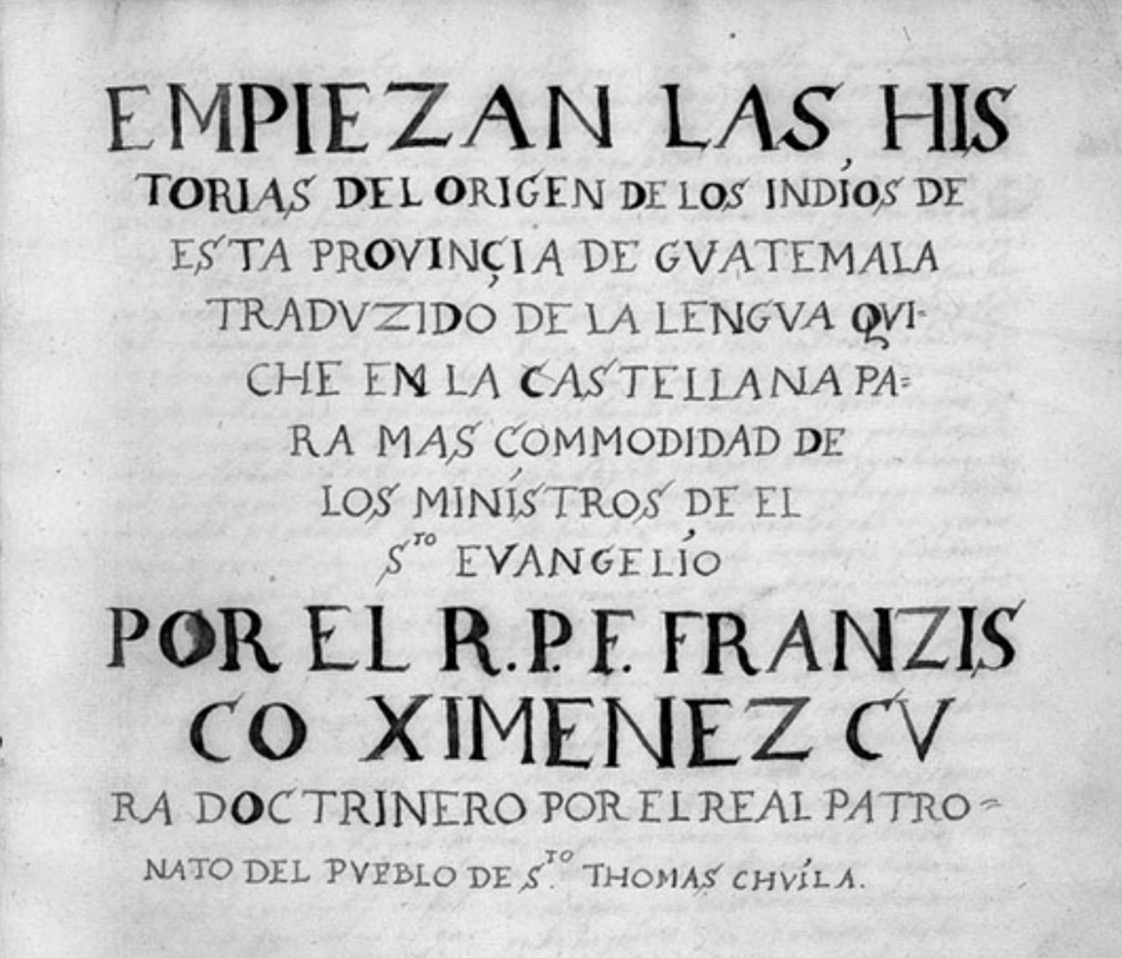
Title page of Ximénez’s manuscript
The manuscript is organized in side-by-side columns, with a word-for-word transcription in Latin script of the native K’iche’ text on one side and the Spanish translation on the other.
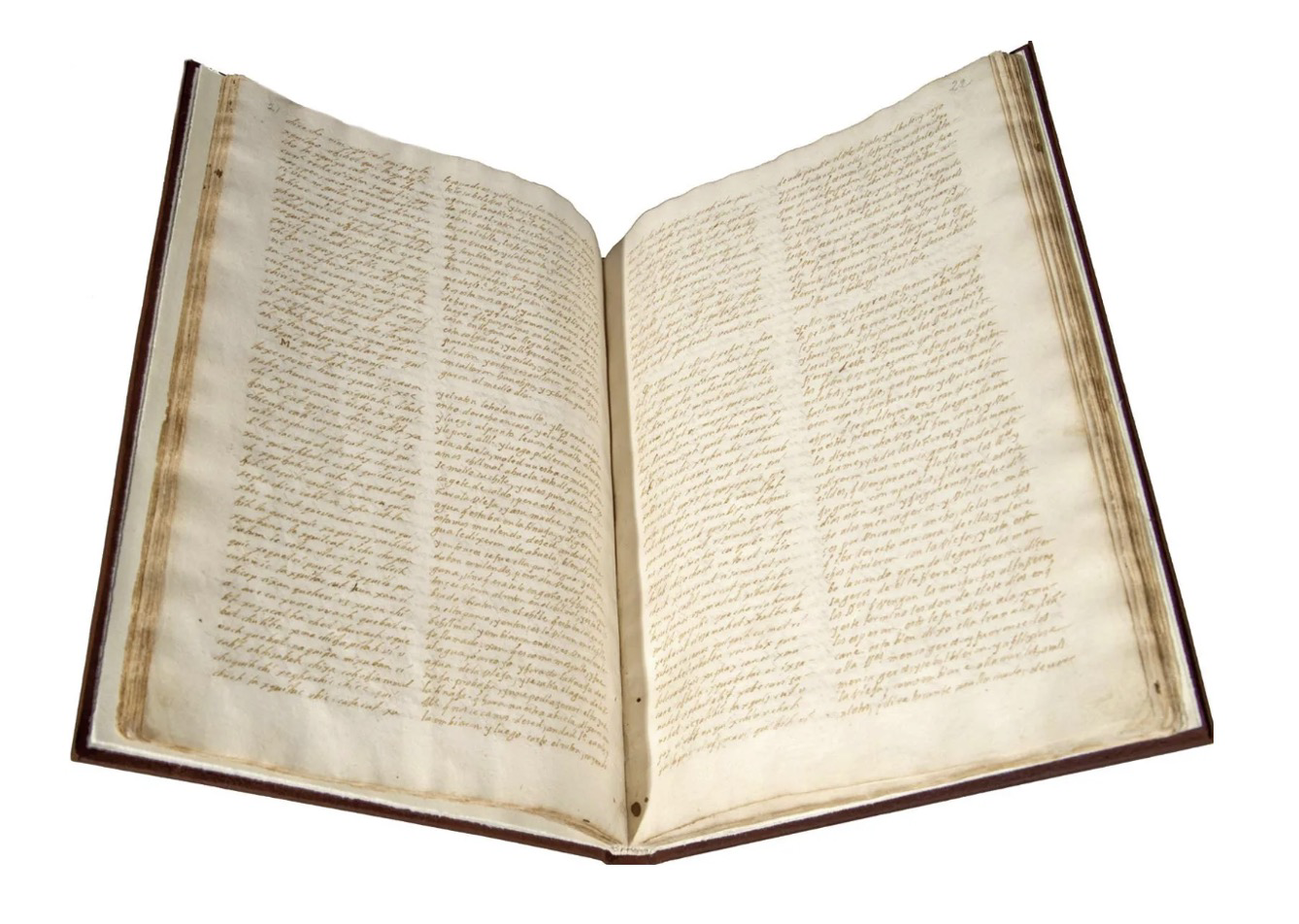
But the journey didn’t end there. The manuscript passed through several hands before being sold to Charles Leclerc, a Parisian bookseller, and to Edward E. Ayer (1841 – 1927) in 1887. Ayer was an American business magnate, best remembered for his bequest of substantial collections of books and original manuscripts from Native American and colonial-era history and ethnology (Wikipedia).
He brought the Popol Vuh manuscript to Chicago, where, since 1912, it has been in the Newberry Library—included among some 17,000 items he donated. It is one of the most widely known and possibly the earliest surviving copy. The Newberry, a renowned research and reference library specializing in the humanities, is home to millions of documents, maps, sheet music, and much more—in short, treasures beyond compare.
Another name in the story of Popol Vuh should be mentioned, namely that of Charles–Étienne Brasseur de Bourbourg (1814 – 1874), a French writer, ethnographer, historian, and archaeologist who specialised in Mesoamerican history and culture. According to Wikipedia, in 1861 he published a French translation of the Popol Vuh and included a grammar of the Kʼicheʼ language and an essay on Central American mythology.
Jaime Arredondo created “Popol Vuh: The Sacred Book of the Quiché through Illustration” in the hope of resurrecting and restoring the former glory of the Popol Vuh and its authors to their deserved place in human history, leading to a greater interest and defense of it and the art and culture of Native and Indigenous peoples. Moreover, these brilliant paintings are his passionate expression of humankind’s love of storytelling and desire to bring to life the history and culture of the Mayan people.
----------------------------------
Please note: all images are courtesy of the artist.
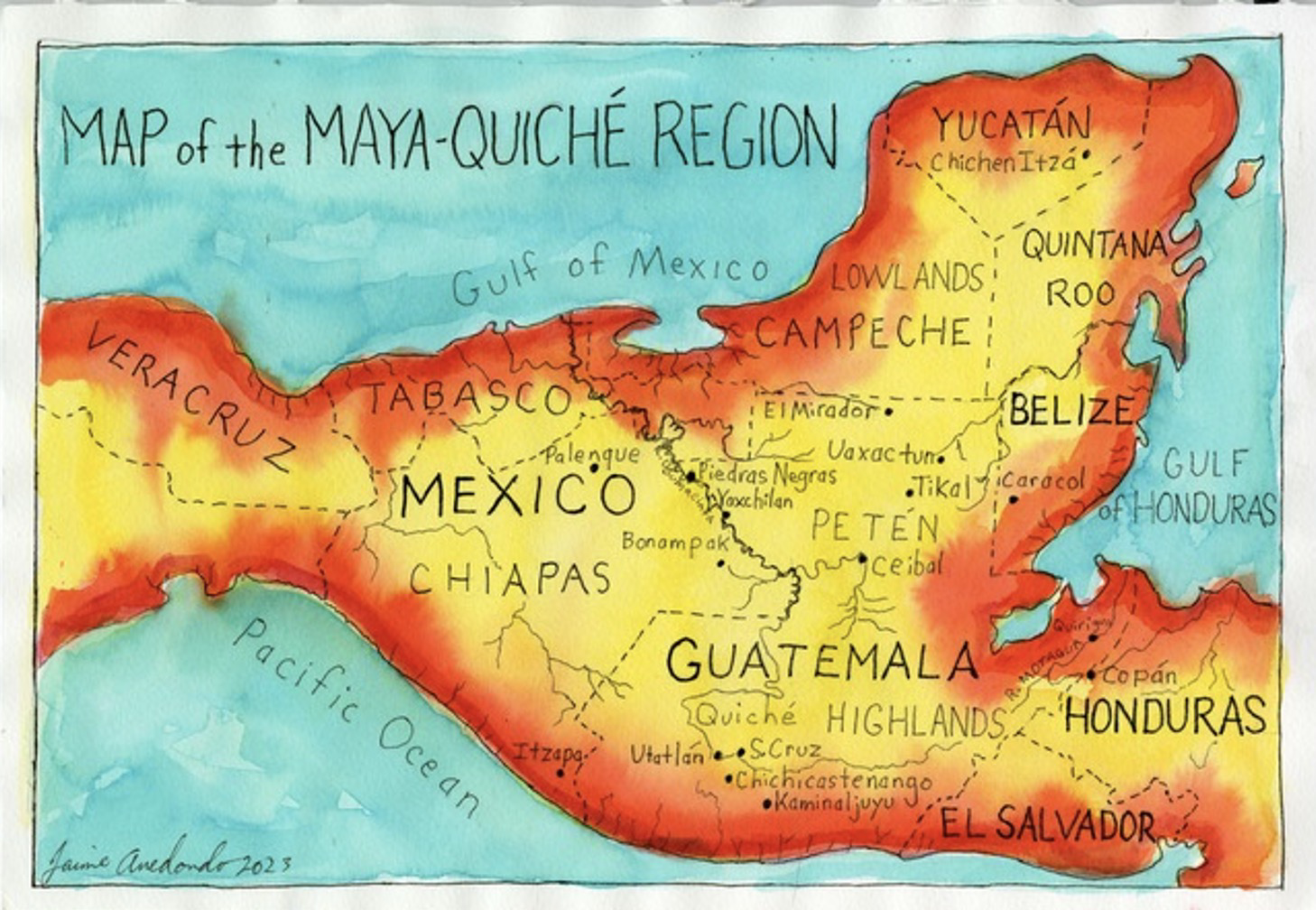
Map of Guatemala and the Maya-Quiché Region, 2023; ink on aluminum, 20 ½” x 14”.
To whet your appetite and have you yearning to come to El Museo Latino and enter the mysterious, magical world of the Maya, here are some select examples of Jaime Arredondo’s art from the exhibit that reveal his limitless imagination and illustration style, which he calls visionary, hallucinatory, surreal.
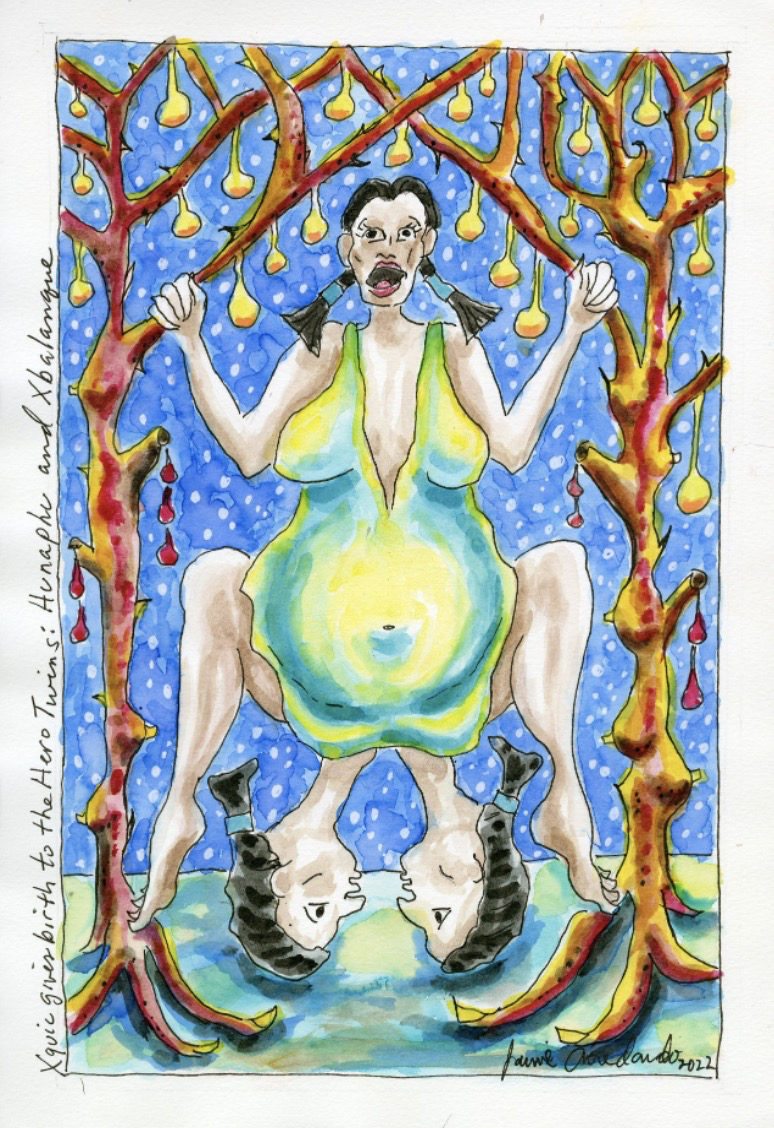
"Xquic gives birth to The Hero Twins: Hunahpu and Xbalanque," 2022; ink on aluminum, 20 ½"× 14".
After the Hero Twins first appear in the story unannounced and then disappear just as mysteriously, the illustration below shows them emerge by birth from a cosmic, semi-divine woman.

"The Head of Hunahpu is replaced by a turtle," 2019; ink on aluminum, 30" x 20 1/2"
Here we see the moment after Hunahpu's head is cut off by Camazotz (the Vampire Bat God), when a turtle fuses with his body and in an almost hallucinatory fashion becomes
Hunahpu's new head.
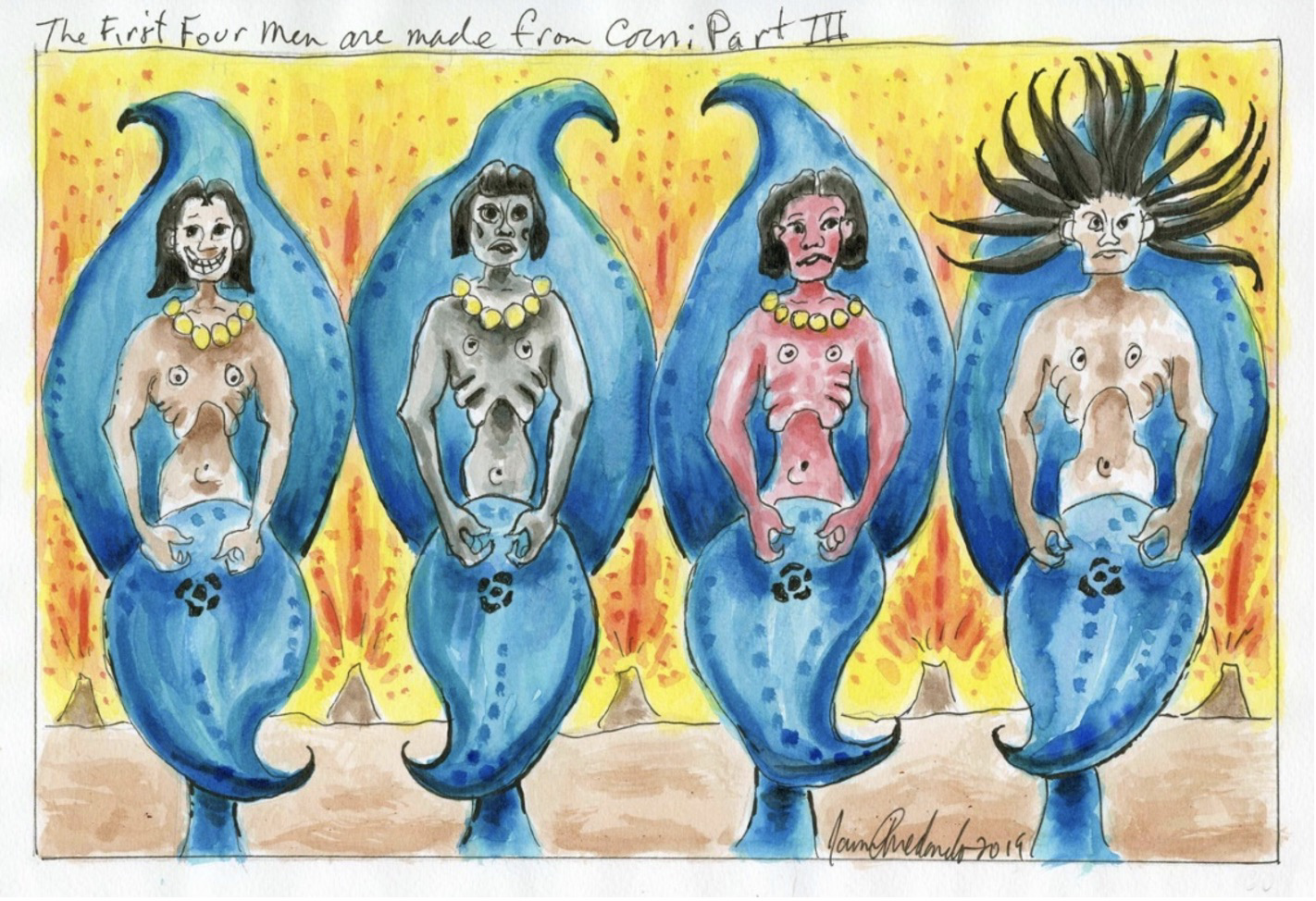
“The First Four Men are made from Corn: Part III” (This is from the first page of Part III of Popol Vuh”), 2019; ink on aluminum, 14 x 20 ½ inches
After several failed attempts to create men—men made from mud, then wood, then Red Bean or Tzite—four men are made from corn. The image is dedicated to the jaguar: the laughing, black, red or spicy, and the ungroomed jaguar.

“All the tribes joyfully worship the first appearance of the Sun and the Morning Star,” 2019; ink on aluminum, 20 ½ x 30 inches
This final illustration represents the creation of the universe. The sun is shown upside down and contains the Mayan glyph for Venus or the Morning Star.
This last of the 65 paintings is the artist’s own favorite.
----------------------------------
About the Artist:
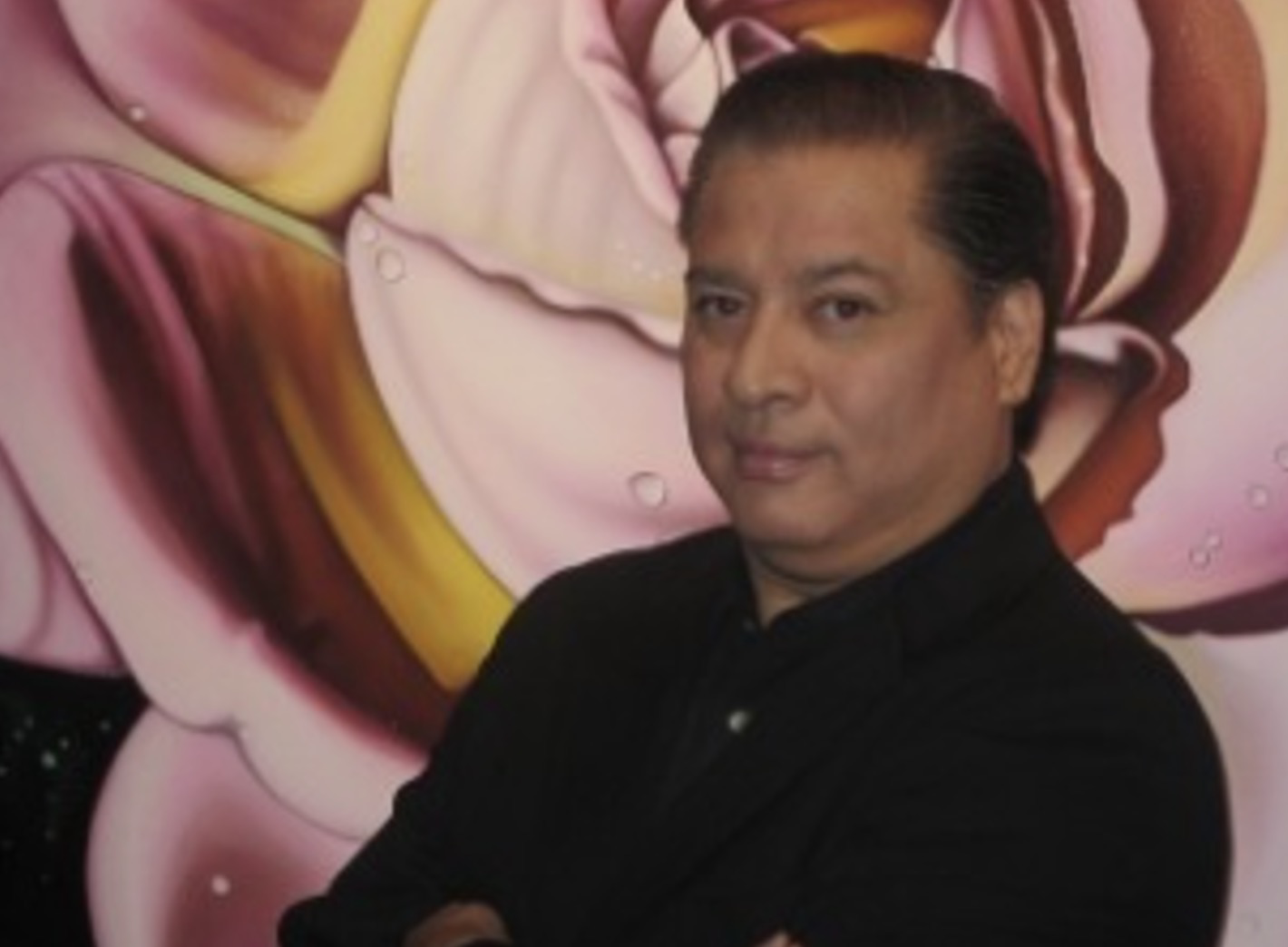
Jaime Arredondo was born in Dallas, TX, to Mexican-American Tejano parents. He is a graduate of the University of Dallas in Irving, TX. His mother was a direct descendant of the original land, granted to Spanish families in Texas, dating back to the 1600s, and his father was Otomi, a large Native American nation originating in Central Mexico. While he was growing up his parents filled his imagination with stories of the borderlands and Mexico—of land, of conquest, of love and betrayal, of spirit, and of soul.
While doing graduate work in fine arts/painting at Yale University, Jaime Arredondo took courses from well-known scholars like Micheal Coe in the field of Mesoamerican studies. And he first became interested in the Popol Vuh when he read about it in various texts as he was doing research for his course “Of Fire and Blood: Art and Mythology of Mexico” that he has been teaching at New York University and The New School for more than two decades. In 2007, he assigned readings on Popol Vuh to his students.
In 2010, wanting to make this complex story more accessible—more “democratic,” he supplemented his reading assignments by creating 26 illustrations to elucidate and clarify the story. The initial illustrations traced the story from the beginning to the middle of the Popol Vuh. Nine years later, in 2019, he completed 39 more illustrations based on the remaining half of the story.
His passion for the Popol Vuh story was made even more memorable and moving to him when, during time spent in Guatemala, he visited the home and church of the translator of the epic, Father Francisco Ximénez in Santo Tomás Chichicastenango.
Jaime Arredondo has had several solo gallery and museum shows in the Southwest and New York City and is the recipient of numerous awards. In 2009, three floral paintings were published as stamps by the United Nations, and in 2015 he was commissioned to create a permanent art project for the Manhattan Transit Authority comprised of 36 mosaics of his works, entitled “Garden of Earthly Delight,” installed at the Zerega Avenue subway station in the Bronx, NY. After graduating from Yale University with a Master of Fine Arts degree in painting, he moved to New York City and began his career at NYU and The New School. He lives in New York City with his wife and daughter.
----------------------------------
About the Irving Archives and Museum
“Popol Vuh: The Sacred Book of the Quiché through Illustration” was on exhibit through February 2024 at the Irving Archives and Museum in Irving, TX. Established in 2020, it is a community-based museum with a mission to engage visitors through thought-provoking programs and dynamic exhibits that explore history and evolving cultures of the community and region.
